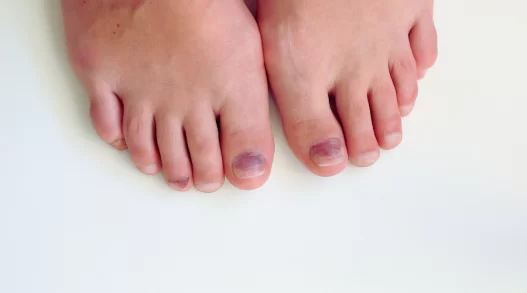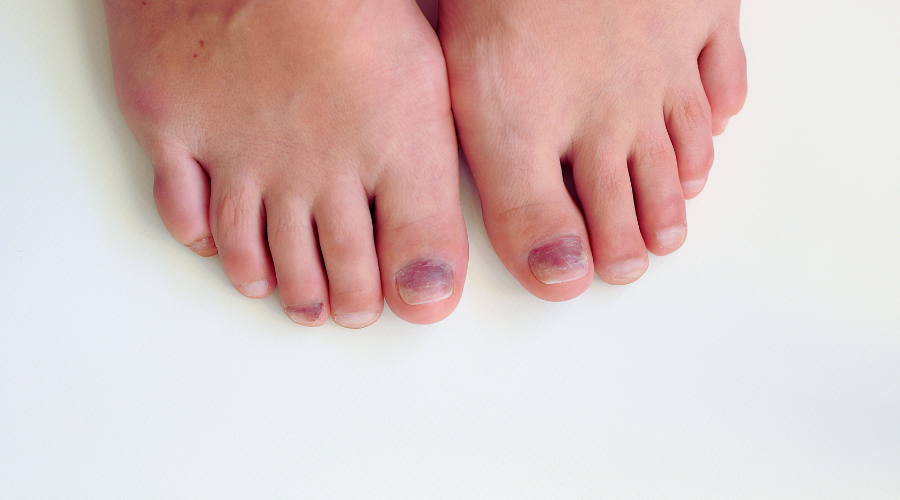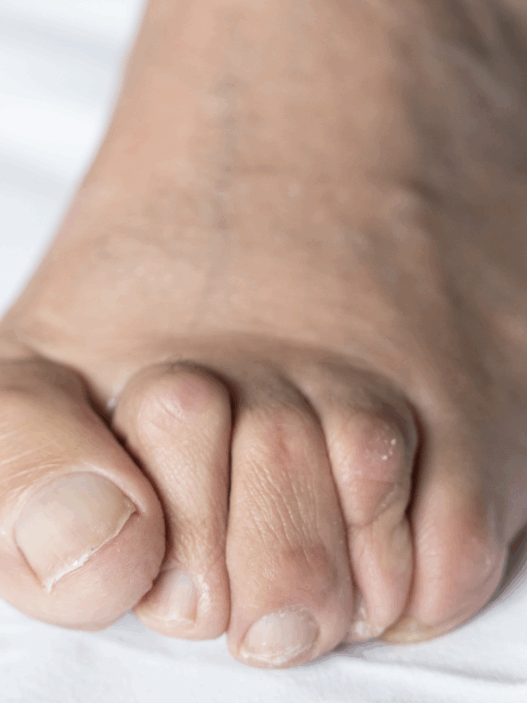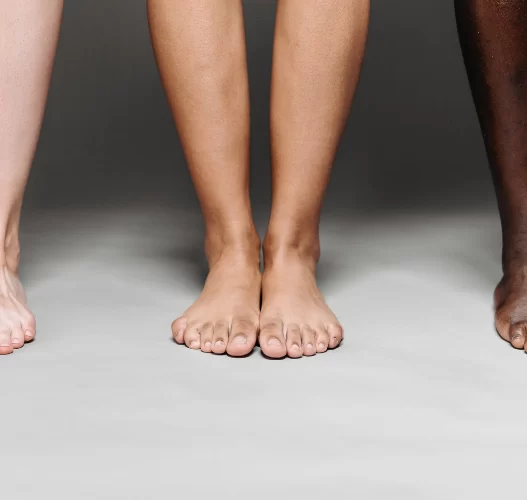Discovering a black spot under your toenail can be alarming. Many patients immediately think of the worst-case scenario – melanoma. While this concern is understandable, I want to reassure you that the vast majority of black spots under toenails are completely benign and treatable.
As a podiatrist at The Foot Hub in Sydney, I see this condition frequently. Many of my patients are surprised to learn that what they’re experiencing is often just a common condition called a subungual hematoma – essentially, a collection of blood under the nail.
Why That Black Spot Is Likely Not What You Fear
Let’s address the elephant in the room first: melanoma under the toenail (subungual melanoma) is rare. Very rare. It accounts for less than 2% of all melanoma cases, which themselves are not common. Meanwhile, subungual hematomas (bleeding under the nail) are incredibly common, especially among active people.
The good news? With a simple examination, a podiatrist can typically distinguish between these and other conditions that cause black spots under the nail.
The Most Common Cause: Subungual Hematoma
A subungual hematoma is essentially bruising that occurs under your nail. Blood collects between the nail plate and the nail bed, creating a dark spot that can appear black, purple, or reddish-brown.
What causes these hematomas?
Many patients are surprised when I tell them they’ve experienced nail trauma because they don’t recall any significant injury. Here’s why:
- Repeated minor trauma – Tight-fitting shoes that press on your toes with each step can cause tiny amounts of bleeding under the nail. This is especially common in active people who walk, run, or play sports regularly.
- Everyday activities in Sydney – Walking up and down hills (which Sydney has plenty of!), taking public transport where you might stand for periods, or even just exploring our beautiful city on foot can contribute to this condition.
- Minor impacts you didn’t notice – Dropping something small on your toe or stubbing it lightly might not register as significant pain but can cause bleeding under the nail.
- Long toenails pressing against shoes – When nails grow too long, everyday pressure from shoes can cause them to press back against the nail bed, causing bleeding.
What many don’t realize is that the black spot might appear days after the actual trauma occurred, making it difficult to connect the cause and effect.
Other Common Causes of Black Spots Under Toenails
While subungual hematomas are the most common cause, there are several other possibilities:
1. Fungal Nail Infections
Fungal infections can sometimes cause dark discoloration under the nail. Unlike a hematoma, which typically appears as a well-defined spot, fungal infections usually cause more widespread discoloration and are often accompanied by changes in nail texture and thickness.
2. Bacterial Infections
Certain bacteria, particularly Pseudomonas, can cause greenish-black discoloration under the nail. This typically occurs when there’s damage to the nail that allows bacteria to enter and multiply in the warm, moist environment.
3. Linear Melanonychia
These are dark streaks that run from the base to the tip of the nail. Most are benign pigmentation, especially in people with darker skin tones where they’re quite common.
4. Splinter Hemorrhages
These appear as thin, dark lines running in the direction of nail growth and are usually the result of tiny blood vessels bleeding in the nail bed. They can be caused by minor trauma or sometimes by certain health conditions.
5. Moles or Benign Pigmentation
Just like you can have moles on your skin, you can have benign pigmented lesions under your nails. These are typically stable in size and color.
The Rare Case: Subungual Melanoma
While I’ve mentioned melanoma, I want to emphasize just how rare subungual melanoma actually is. The vast majority of black spots under toenails are completely harmless.
That said, if a dark spot under your nail has been present for a long time, is changing in appearance, or doesn’t seem to be growing out with the nail, it’s worth having a podiatrist take a look. We can easily determine if there’s anything that requires further attention.
Remember, even if you need a referral for further assessment, this doesn’t mean you have melanoma – it simply means we’re being thorough with your foot health.
How a Podiatrist Can Help
As podiatrists, we’re trained to identify the various causes of nail discoloration. During an examination, we can typically determine:
- If it’s a hematoma: We can often tell by the appearance and may use a technique called dermoscopy to examine the nail more closely.
- If it’s likely benign: Most cases are clearly benign based on their appearance, history, and how they’ve evolved over time.
- If it needs further investigation: In the unlikely event that the lesion has suspicious features, we can refer you to a dermatologist for further assessment.
In some cases, we might recommend draining a painful hematoma (if it’s recent) or thinning the nail to get a better look at what’s underneath.
What You Can Do Now
If you’ve noticed a black spot under your toenail:
- Don’t panic – Remember that the vast majority of these spots are harmless.
- Check your footwear – Are your shoes tight in the toe box? This is a common cause of subungual hematomas.
- Monitor it – Take a photo and check if it’s growing or changing rapidly.
- See a podiatrist – A professional assessment can quickly put your mind at ease or guide you to appropriate treatment.
Patients are often relieved to learn that most black spots under toenails are simply the result of everyday activities and typically grow out with the nail over time.
When to Seek Immediate Attention
While most black spots can wait for a routine podiatry appointment, you should seek more urgent medical attention if:
- The spot appeared after a significant injury and is causing severe pain
- There’s significant swelling, redness, or discharge (signs of infection)
- The spot is rapidly changing in size or appearance
- You have a personal or family history of melanoma and are concerned
Frequently Asked Questions
How long will it take for a black spot under my toenail to grow out?
Toenails grow quite slowly – about 1-2mm per month. Depending on where the black spot is located, it could take anywhere from 6-18 months to grow out completely. Spots closer to the tip will grow out faster than those near the base of the nail.
Can I just drill a hole in my nail to relieve the pressure from a hematoma?
While this is sometimes done by medical professionals for very recent, painful hematomas, we don’t recommend trying this at home. The risk of infection or further damage is high. If your black spot is causing significant pain and appeared within the last 48 hours, see a podiatrist who can safely drain it if appropriate.
Will the black spot come back after it grows out?
If the cause was a one-time trauma (like dropping something on your toe), the spot typically won’t return once it’s grown out. However, if the cause is ongoing pressure from footwear or activity, new spots may appear. This is why addressing the underlying cause is important.
How can I prevent black spots from forming under my toenails?
Wear properly fitted shoes with enough room in the toe box, keep toenails trimmed to an appropriate length, and consider protective gear during sports. If you’re very active, be mindful of how your feet feel in your shoes – discomfort is often a warning sign.
Can nail polish hide these spots until they grow out?
Yes, nail polish can be used to hide the appearance of a black spot while it grows out, provided a podiatrist has confirmed it’s just a hematoma. However, if you haven’t had the spot assessed, we recommend doing so before covering it up.
Book an Assessment
Our podiatry team at The Foot Hub can help identify the cause of black spots under your toenails and provide appropriate treatment or referral if needed. Don’t lose sleep over a nail discoloration – most are easily explained and completely benign.
Remember, melanoma under the nail is rare, but early assessment of any unusual nail changes is always a good idea for your peace of mind.
Book your appointment online or call us 02 8096 4763 to have your nails professionally assessed by our experienced Sydney podiatrists.
 About the Author: Dr. Rudo Makuyana is a podiatrist with over 10 years of experience practicing in Sydney, Australia. She specializes in treating nail conditions and foot health.
About the Author: Dr. Rudo Makuyana is a podiatrist with over 10 years of experience practicing in Sydney, Australia. She specializes in treating nail conditions and foot health.











